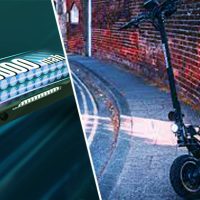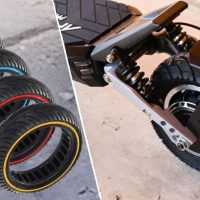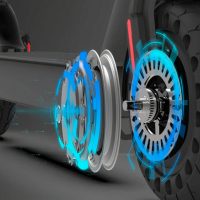One of the critical components of an electric scooter is its battery, which powers the vehicle. In this article, we will delve into the different types of electric scooter batteries available in the market today and discuss their features and advantages. So, let’s explore the world of electric scooter batteries!
Different Types of electric scooter Batteries
Electric scooters typically use two types of batteries, including lead-acid or lithium-ion.
1. Lead Acid Battery

Lead-acid batteries have been used in electric scooters for many years. These batteries are relatively inexpensive compared to Lithium-ion batteries. However, they are also heavy and have a shorter lifespan compared to lithium-ion batteries.
- They contain toxic materials such as lead and sulfuric acid, which can pose a risk to the environment if not disposed of properly.
Pros
- Relatively inexpensive
- Widely available
- Easy to recycle
Cons
- Heavy and bulky
- Shorter lifespan compared to lithium-ion batteries
- Contain toxic materials that can harm the environment
2. Lithium-ion Battery

Lithium-ion batteries, on the other hand, are lighter and more efficient than lead-acid batteries. They have a longer lifespan and are also more environmentally friendly.
However, these batteries are more expensive than lead-acid batteries. Also, there have been concerns raised about their safety in recent years.
Pros
- Lighter and more efficient than lead-acid batteries
- Longer lifespan
- More environmentally friendly
- Can be recycled
Cons
- More expensive than lead-acid batteries
- Risk of overheating and explosion if damaged or overcharged
- Need proper handling and storage
Do lithium-ion batteries charge faster than lead acid?
Yes, lithium-ion batteries charge faster than lead-acid batteries. This is because lithium-ion batteries have a higher energy density, which means they can store more energy in a smaller and lighter package.
The higher energy density also allows for a faster charge rate, as more energy can be transferred to the battery in a shorter amount of time.
On the contrary, lead-acid batteries have a lower energy density, which means they can store less energy in a larger and heavier package. This lower energy density also limits their charge rate, as they cannot absorb energy as quickly as lithium-ion batteries.
However, it’s important to note that the charging time of a battery also depends on the charging system used, the state of charge of the battery, and other factors such as temperature and battery capacity.
So while lithium-ion batteries generally charge faster than lead-acid batteries, the actual charging time will depend on various factors and may differ between different batteries and charging systems.
Lead acid battery vs. lithium-ion battery life
Lithium-ion batteries have a longer lifespan than lead-acid batteries.
Lead-acid batteries typically have a lifespan of around 200-300 charge cycles, which means they can be recharged and discharged approximately 200-300 times before their performance starts to decline significantly. After this point, the battery may not be able to hold its charge as well and may need to be replaced.
On the other hand, lithium-ion batteries can typically last for several hundred to a few thousand charge cycles before their performance starts to decline. Some high-quality lithium-ion batteries can last for more than 1000 charge cycles.
Lead-acid batteries are more sensitive to the depth of discharge (DOD), which refers to how much of the battery’s capacity has been used. If a lead-acid battery is frequently discharged to a deep DOD, its lifespan can be shortened.
Lithium-ion batteries are less sensitive to DOD and can handle deeper discharges without significantly affecting their lifespan.
How to tell if the battery is lead acid or lithium?
There are a few ways to tell if a battery is a lead-acid or lithium-ion battery.
- Lead-acid batteries are much heavier than lithium-ion batteries. If you have two batteries of the same size, the significantly heavier one is likely to be a lead-acid battery.
- Lead-acid batteries have a voltage of 6 or 12 volts, whereas lithium-ion batteries typically have a voltage of 3.7 to 4.2 volts. You can use a voltmeter to check the voltage of the battery.
- Lead-acid batteries are rectangular or square in shape, with a plastic or hard rubber casing. Lithium-ion batteries are often cylindrical or rectangular in shape, with a metal or plastic case.
- The battery’s label or packaging may indicate whether it is a lead-acid or lithium-ion battery. Look for words such as “lead-acid” or “lithium-ion” on the label or packaging.
- It’s important to note that some batteries, such as nickel-cadmium batteries, may look similar to lead-acid or lithium-ion batteries. So if you’re not sure what type of battery you have, check the label or packaging or consult with a professional.
Final words:
when it comes to electric scooter batteries, lithium-ion batteries, especially the LiFePO4 variant, are the preferred choice due to their high energy density, lightweight design, and long lifespan. While other options like sealed lead acid and nickel-metal hydride batteries exist, they have limitations in terms of weight, maintenance, and energy density. By selecting the right battery for your electric scooter, you can ensure optimal performance and enjoy a seamless riding experience.
Frequently Asked Questions (FAQs)
- What is the average lifespan of an electric scooter battery?
The average lifespan of an electric scooter battery is typically between 2 to 4 years, depending on factors such as usage, maintenance, and battery type.
- How long does it take to charge an electric scooter battery?
Charging times for electric scooter batteries can range from 4 to 8 hours, depending on the battery capacity and charger specifications.
- Can I upgrade the battery on my electric scooter?
In some cases, it is possible to upgrade the battery on an electric scooter, but it is recommended to consult the manufacturer or a professional to ensure compatibility and avoid potential issues.
Arnold A. Jones: Your go-to source for electric scooters, hoverboards, and skateboards! Riding enthusiast and expert sharing tips, trends, and insights for riders of all levels. Stay in the know with Arnold’s expertise.







Leave a Reply